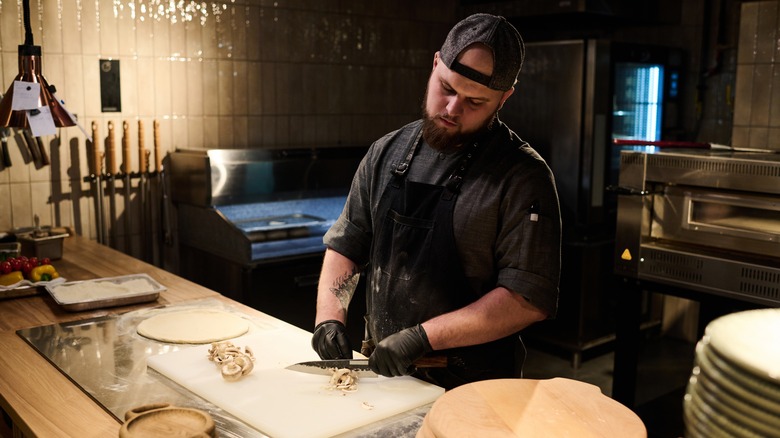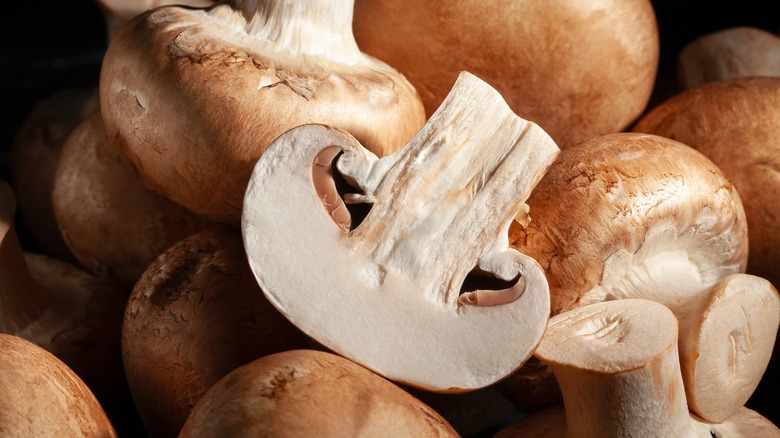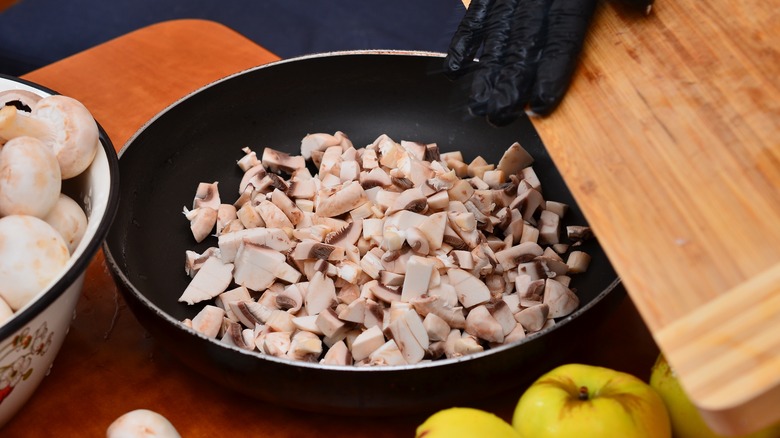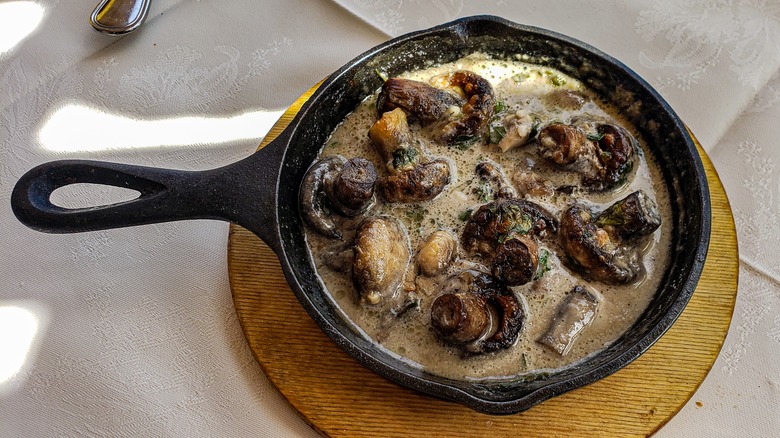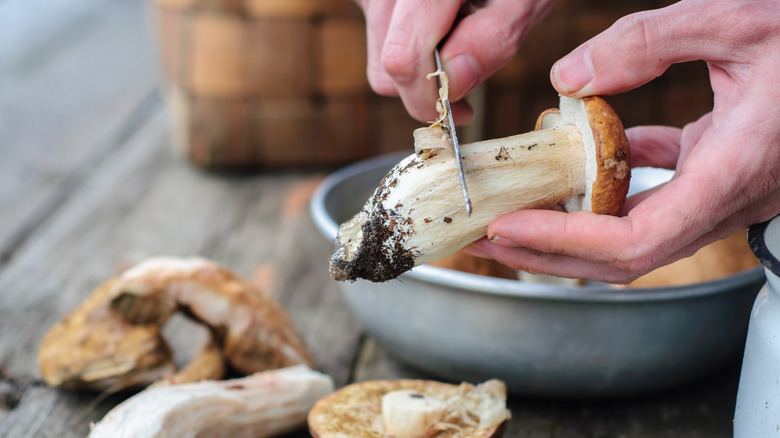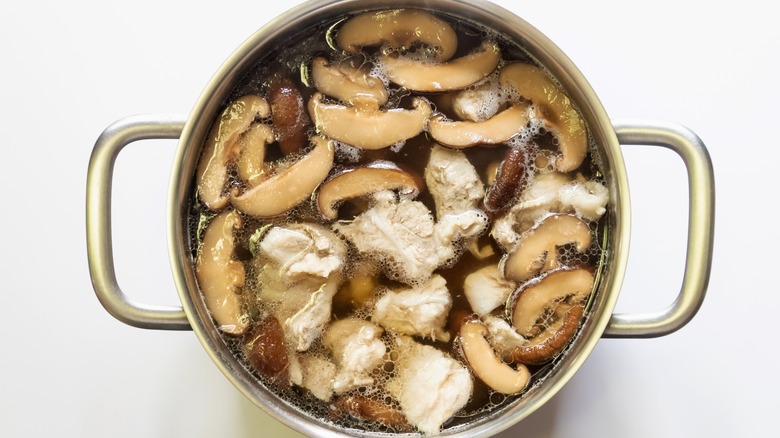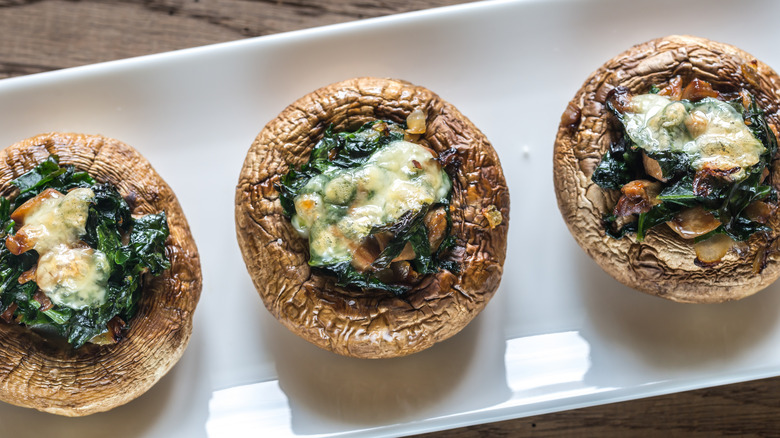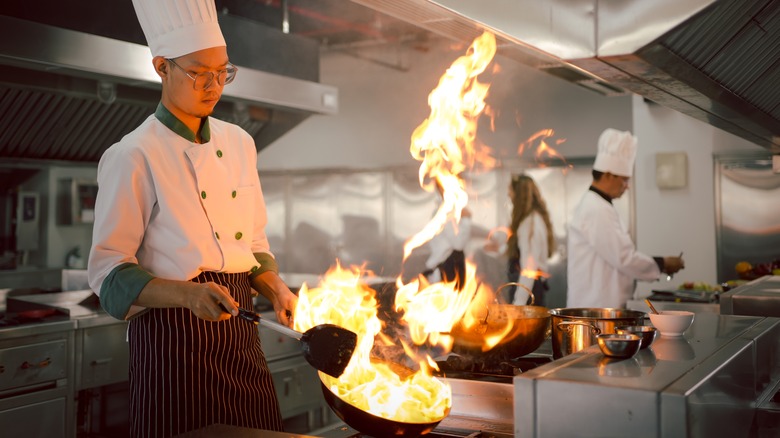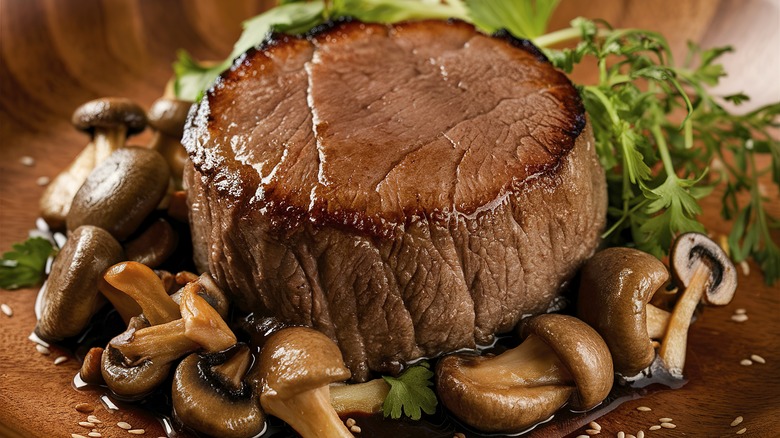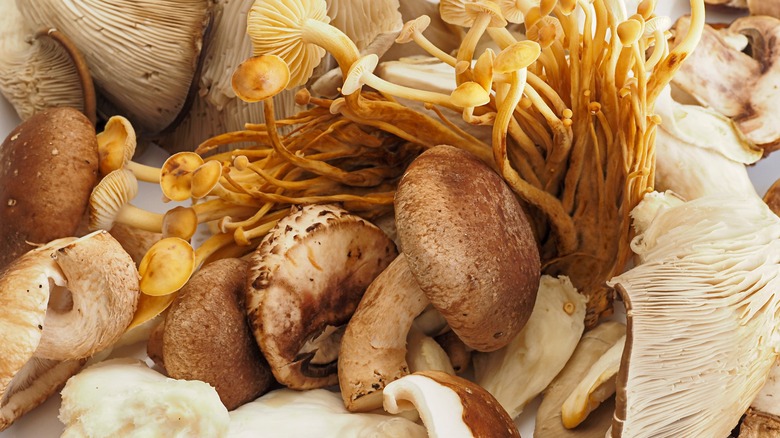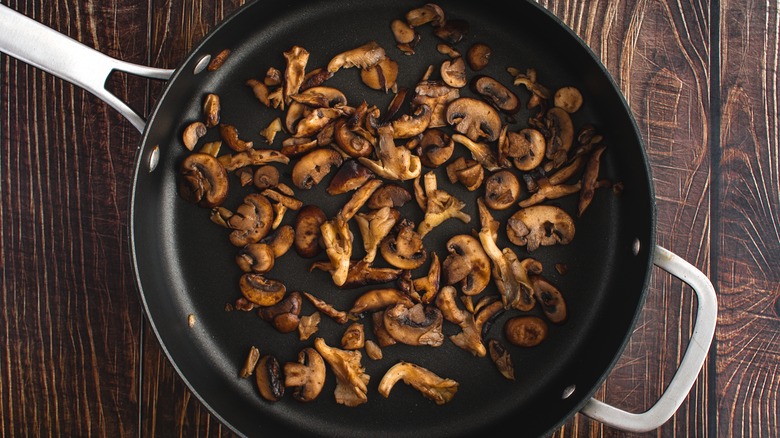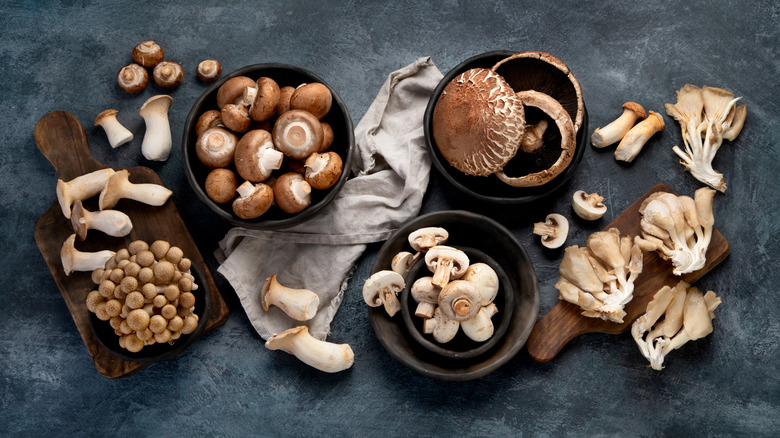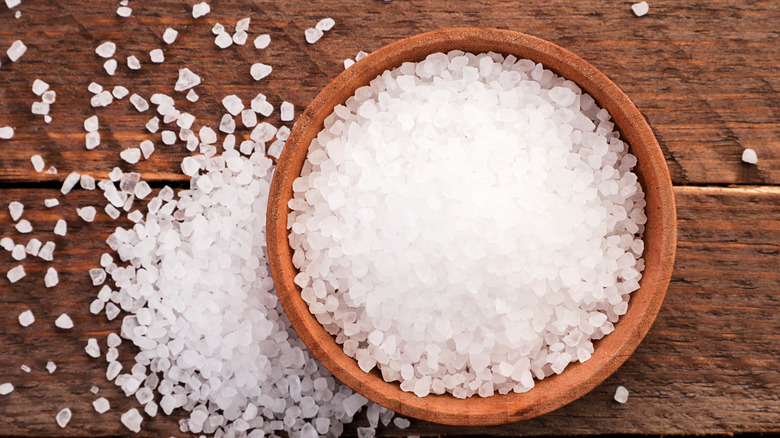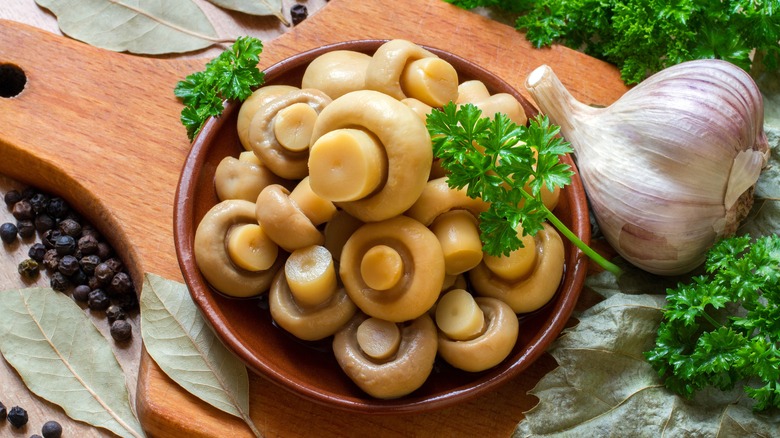14 Insider Tricks Restaurants Use To Make The Most Delicious Mushrooms
Even with our best efforts, restaurants are able to make foods more delicious than us regular folks could ever make at home. A great example of this is mushrooms. Whether it's employing nifty knife tricks to infuse them with extra flavor, utilizing more mushroom varieties, or cooking them in fat, restaurant chefs and cooks know how to make mushrooms taste their very best; however, with a little help, you can start using some of these same tricks and enjoying drool-worthy mushrooms at home.
To round up a list of 14 tricks restaurants use to make the most delicious mushrooms, I first tapped into my extensive experience in the food service industry. I've worked in all different kinds of bars, diners, and restaurants over the last 20 years. While I was primarily a bartender and server, I was always very familiar with the menu and how dishes were prepared so I could answer guests' inquiries. I also wasn't afraid to ask the chefs questions (some might say incessantly), so I picked up quite a few tips and tricks along the way. In addition, I found a few of the techniques included here by searching through recommendations from celebrity chefs like Gordon Ramsay, Ina Garten, Giada De Laurentiis, and more. So, take a note (or several) from the pros, and watch as your mushroom cooking skills advance to a higher level — you won't regret it.
1. Scoring the caps so they soak up more flavor and release moisture
Mushrooms have an inherently high water content, but much of this is released while cooking (at least if you're doing it right, and you better believe restaurants are). One technique chefs and restaurant cooks use to help mushrooms reach their full potential is scoring the tops or cross sections. Typically, a diamond pattern is scored into a mushroom using a super sharp knife. It takes precision, but it's worth the effort. Not only does scoring have eye-catching appeal (kind of like grill marks), but it improves cooking results and increases flavor retention.
I've been falling down the Gordon Ramsay reality T.V. series rabbit hole for a while now, and I've seen the man himself demonstrate scoring mushrooms on "Master Chef" many times. Of course, he makes it look easy, but you should be able to pull it off, even if it doesn't look very pretty the first time. Start by making diagonal cuts from the upper left side of your mushroom down to the lower right. Then, switch to the other side and make cuts from the upper right down to the bottom left. When you're done, you'll have a diamond-shaped grid ready for cooking.
2. Start by dry frying to release extra moisture
Another fantastic technique professional chefs and restaurants use to help mushrooms release excess moisture is dry frying them first. All this entails is putting them in a pan and sautéing them without the addition of oil (or any other kind of fat or seasoning). This initial sauté allows the mushrooms' high water content to dissipate before adding seasonings and fat. That way, the mushrooms become tender but not mushy after cooking. In addition, this helps the edges crisp up nicely later on.
Kristen Kish, Season 10 winner (and now host) of "Top Chef," confirms in her cookbook "Kristen Kish Cooking: Recipes and Techniques" that dry frying is super beneficial. She knows mushrooms can get soggy if they aren't dried out, either in the oven or in a pan. If you don't do this first, she says they'll steam and simmer in their own unflavored liquid. As a result, they won't soak up the flavors and fat you want them to absorb. After dry frying, chefs proceed as normal and add fat and other flavors; however, this first step is crucial in ensuring your mushrooms are not only delicious but also perfectly textured.
3. Not holding back on butter or other types of fat
At home, many people hold back on using lots of fat, like oil or butter; restaurant chefs, however, use them in abundance. Whether they're sautéing, roasting, frying, or marinating, professional cooks prepare their mushrooms with some kind of fat, and often a lot of it. Olive oil is pretty common. It has a slightly earthy taste that matches the flavor of most mushrooms. More than one of the restaurants I worked at used bacon fat, which, as you can imagine, led to drool-worthy flavor.
I worked in another more fine-dining restaurant that offered crab-stuffed mushrooms served in what was essentially a bath of melted butter. The first time I saw the dish, I thought, "Wow, that's a lot of butter." But people loved them — like, really loved them — and the pool of butter was one of the main reasons why. The crab was pretty decadent, too, but the butter made the mushrooms beyond flavorful. I guess that's not too surprising, though, because butter makes everything better — just ask any Southern cook.
4. Cleaning them with care
Most mushrooms are pretty fragile, so cleaning them isn't as straightforward as other veggies. Instead of rinsing them off with water like you would with just about any other produce, the best way to clean mushrooms is to wipe them down with a slightly damp cloth or paper towel. Of course, you can't press too hard, and you'll need to remove the stems and gills on many mushrooms first, but essentially, they must be delicately cleaned by hand.
For a novice home cook, cleaning mushrooms with any semblance of accuracy may be somewhat intimidating, but professional chefs and line cooks know exactly how to go about the task. Learning to clean mushrooms the right way isn't really all that difficult. Still, if you do it wrong, leftover dirt and maybe even pesticides can alter the flavor of the food you put them in. Plus, no one wants to bite into grit and dirt, regardless of the dish. Restaurants take all the extra precautions needed to ensure this never happens. Of course, mistakes happen from time to time, but pros have lots of practice, and this pays off in the long run.
5. Simmering in water to bring out flavor
If you've ever enjoyed thick, juicy slices of sautéed mushroom at a restaurant, you may have wondered how the cooks managed to make them so succulent and tender. Well, there's a good chance they simmered them in water before sautéing. This may seem counterintuitive since mushrooms already have a high water content, but simmering mushrooms in salted water gives them a savory boost, and it also makes them more tender.
This trick takes an alternative approach to dry frying, at least at first. Chef Jim Fuller, who specializes in meat alternatives and is a co-founder of Fable Food, believes mushrooms should be boiled until perfectly tender (via The Standard). Then, you cook off all of the water until the pan is dry and no excess moisture remains. After that, you move forward by adding herbs, spices, and fat, then briefly sauté until seasoned to taste. Interestingly enough, it's impossible to over-boil mushrooms, so infusing them with salt water first only improves their flavor in the end.
6. Stuffing them with rich ingredients
Stuffing mushrooms with savory ingredients is another time-honored chef tradition. Conveniently, many mushroom caps are shaped like miniature cups, so filling them with delicious ingredients is super simple. It also gives dishes a beautiful, eye-catching appeal, something professional chefs always strive for.
Really, there's no limit to what you can stuff mushrooms with. As I briefly touched upon already, I worked at a restaurant that served mushrooms stuffed with crab meat and garlic. Needless to say, they were a big hit. Celebrity chef Giada De Laurentiis' Stuffed Mushrooms recipe on the Food Network website calls for white mushrooms stuffed with Italian breadcrumbs, Pecorino Romano cheese, garlic, and other herbs and spices. Considering she's the queen of Italian-American cuisine, I'm sure they're beyond delicious. The Barefoot Contessa, Ina Garten, stuffs her mushrooms with sausage, scallions, panko, mascarpone and Parmesan cheeses, garlic, and other seasonings, per the recipe on her website. Yum!
While mushrooms are tasty all by themselves (especially when prepared correctly), you can see that chefs love stuffing them, too. This technique turns what would be a simple side dish or add-on into a decadent appetizer, main course, or light lunch.
7. Searing on high heat to create crispy edges
Searing mushrooms on high heat results in beautifully crispy, caramelized edges and a serious boost in flavor. Instead of the slimy texture of improperly sautéed mushrooms, this method gives you varying textures and a rich, deep flavor. Sounds delicious, right? It is, and chefs know how to cook mushrooms so they turn out like this every single time.
If you want to try your hand at caramelizing mushrooms, it's fairly easy, but it does take time and patience. To start, you want your pan to be super hot. A proper sear always starts with a piping-hot pan and as little moisture as possible. Then, you simply put the mushrooms in the pan and leave them to brown. It may be tempting to stir and move the mushrooms around, but don't do it. This will make it harder to evenly brown the edges. Depending on the size of your mushrooms, somewhere between four and eight minutes should suffice.
8. Braising in wine, marsala, or stock for delicious flavor and a tender texture
Braising meat is pretty much standard when cooking steaks and other proteins in a restaurant. If you've ever watched a cooking competition show, you've likely seen this done several times; however, what you may not know is that this technique works great with mushrooms, too. After all, they are the meatiest of all the vegetables. Just like with a thick cut of beef or fish, braising mushrooms infuses them with rich flavors right at the end and ensures they don't dry out.
Giada De Laurentiis' Simple Braised Mushrooms recipe on the Food Network website calls for chicken or vegetable stock and also lists the option to add marsala, sherry, or white wine (I don't know why you'd leave it out, though — a restaurant wouldn't). On her blog, Giadzy, De Laurentiis says she loves how well mushrooms soak up the flavors of wine. She also notes that it makes them feel more gourmet. If red wine is more your style, you can braise mushrooms with that, as well. Either way, you'll be in for a treat.
9. Only cooking the freshest mushrooms
The best-tasting foods start with the freshest ingredients, and restaurants know this. Whether or not they choose to use them is a different matter — it really depends on the spot. Since we're talking about restaurants that do things the right way, though, you can bet these establishments stick to buying the freshest produce, mushrooms included. In fact, some fine-dining restaurants pick up their produce on a daily basis to ensure freshness.
Using the freshest possible mushrooms sounds great and all, but food costs are a major concern for restaurants. As a result, they won't just throw away their mushrooms once they pass peak freshness. In the restaurants where I worked, they simply went into a stew, scramble, or some kind of sauce. That way, the chefs could mask the fact that they weren't the epitome of freshness. If you find yourself in a similar situation, I recommend you do the same.
If you want to recreate the delicious taste of quality restaurant mushrooms, you certainly don't want to start with a canned or frozen product. Always grab your mushrooms from the fresh produce section of your grocery store. Or, if you live near a farmer's market, I recommend trying your luck there. Many farmer's markets have super fresh produce, some of which was likely picked that same day. You may also be able to find special mushroom vendors that offer more exotic options than you would find at your typical grocery store.
10. Not overcrowding the pan
One mistake restaurant chefs never make is overcrowding a pan with too many mushrooms. Of course, they typically make only one or two servings at a time, but still, this is a big no-no. As Julia Child recommended, it's best to leave room for mushrooms to spread out in a pan. If they're crowded, they won't sauté. Instead, they'll steam, giving them an entirely different texture and outcome.
To avoid overcrowding and accidentally steaming your mushrooms when you want to sauté them, Gordon Ramsay recommends on his website that you work in batches if needed. This may take a few extra minutes, but the finished result is more than worth the hassle as far as texture is concerned. You can set your first batch aside and proceed with another. Then, combine them all in the final minutes for a quick braise or to simply create a cohesive dish and ensure everything is hot.
11. Using all different kinds of mushrooms
Many people stick to a small selection of common mushrooms when cooking at home. Not only are varieties like button, cremini, and Portobello widely available at grocery stores, but they're included in a wide range of recipes; however, there are actually more than 2,000 types of edible mushrooms, and restaurants aren't afraid to dive headfirst into the world of fungi. From morel to chanterelle to king trumpet to lobster mushrooms (yes, they taste kind of like lobster), restaurants don't shy away from using lesser-known varieties. For the most part, expanding beyond your typical, run-of-the-mill mushrooms only leads to a more unique flavor.
Chef Dominique Crenn is an avid mushroom lover known for creating inventive dishes with a collection of wild mushrooms. She told Incredible Mushrooms in an interview that these fungi infuse her dishes with elements of the forest. Crenn is the proud recipient of three Michelin Stars for her prestigious restaurant, Atelier Crenn; in fact, she was the first woman in the U.S. to be awarded this high honor. She definitely knows what she's talking about, so take notes from her and don't limit yourself to just a couple of mushrooms when cooking them at home. In case you're wondering, some of her favorites include morel, shiitake, and lion's mane.
12. Finishing with a sprinkle of coarse salt
There are many ways to add more flavor to mushrooms, but sprinkling them with a touch of salt at the end of the cooking process (or right before) is one of the best. Adding salt as a final touch helps accentuate the mushrooms' inherent nutty, savory flavors; however, timing is key, and restaurant chefs are no strangers to this concept. If you salt mushrooms too soon, more moisture is extracted than is ideal. This may sound insignificant, but it actually leads to a chewier, tougher texture and makes achieving the perfect golden-brown color more difficult.
I know I keep talking about the restaurant I worked at with the crab-stuffed mushrooms, but they were done perfectly. I'm sure the crab and abundance of butter in the dish didn't hurt, but one thing that put the dish over the top flavor-wise was a final garnish of coarse sea salt just before the dish was taken to the table. This final flourish paid off in spades when you got a bite with a flake or two of salt. It made all the other elements burst with flavor. Give this simple trick a try at home, and you'll be amazed at how much of a difference this nearly effortless addition makes.
13. Marinating for deep flavor
Marinating mushrooms in advance is another way restaurants and professional chefs infuse them with deep flavor. It's also a great way to make adding them to dishes quick and easy. It's particularly helpful for salads or antipasto plates. The only catch is that they need to be prepared three or four days in advance because the longer mushrooms marinate, the deeper the flavor becomes.
In this YouTube clip, Gordon Ramsay starts his marinated button mushrooms by sautéing them to add a nice color and enhance flavor. Then, he adds diced shallots and vinegar to create a nice balance of sweet and savory elements. After sautéing for a couple of minutes, he takes them out of the pan to cool and adds fresh tarragon. To finish, Ramsay says to leave them so they can cool and marinate for at least 24 hours. After that, they're delicious whether you eat them cold or reheated.
14. Making creative recipes
Restaurants know that serving creative dishes is often what keeps guests coming back. If you go to a spot and find menu items that are new and exciting, one visit won't be enough. While this isn't everything, it's one of the reasons mushrooms, in particular, taste so good at restaurants. Chefs spend lots of time and effort creating appealing dishes that are not only delicious but also eye-catching.
Dominique Crenn knows the importance of this, as is evident by her inspired dishes that are practically works of art. As she described to Incredible Mushrooms, one of the ways she creates her beautiful plates is by using sautéed, pureed, dried, and pickled mushrooms. She isn't afraid to explore textures and creative elements to bring together her gorgeous dishes, and you shouldn't be, either. If you branch out from the typical side dish of sautéed mushrooms, there's no limit to the delicious recipes you can make.
If you're looking for ideas, tagliatelle with maitake mushrooms and pickled chiles or vegan mushroom fettuccine Alfredo are great places to start. Or, for something to warm you up, try porcini mushroom and herb soup (it's vegan, too). Now that you know about all kinds of tricks and tips, try some out — your mushrooms may even rival those of your favorite restaurant.

